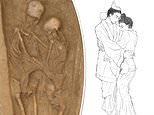Skeletons found embracing in ‘eternal love lock’ in 1,500-year-old Chinese grave
Ancient Chinese woman ‘sacrificed herself’ 1,500 years ago so her dead body could be buried in an ‘eternal love lock’ embrace with her lover’s corpse after he died
Archaeologists uncovered the 1,500 year-old skeletal remains of a man and woman positioned in an ‘eternal love lock’ in northern ChinaThey were found in June 2020 while workers excavated the Shanxi provinceThe man was believed to be between 29-35 and had signs of traumaThe woman was between 35-40 and likely sacrificed herself to be buried The burial is the first of its kind in China and a sign that changes towards love happened during the North Wei DynastyApproximately 600 burials, including other couples, were found in the cemetery
<!–
<!–
<!–<!–
<!–
(function (src, d, tag){
var s = d.createElement(tag), prev = d.getElementsByTagName(tag)[0];
s.src = src;
prev.parentNode.insertBefore(s, prev);
}(“https://www.dailymail.co.uk/static/gunther/1.17.0/async_bundle–.js”, document, “script”));
<!–
DM.loadCSS(“https://www.dailymail.co.uk/static/gunther/gunther-2159/video_bundle–.css”);
<!–
Archaeologists have uncovered the skeletal remains of a man and woman buried for more than 1,500 years in northern China, with the two remains positioned in an ‘eternal love lock.’
The man, believed to be between 29 and 35 at the time of death, was likely around 5ft4in and had ‘several signs of … trauma,’ including a broken arm, a missing ring finger on his right hand and issues with his feet.
The woman was roughly 5ft2in and between 35 and 40 at the time of her death.
It’s unclear how the male and female ended up in the same grave, though it’s possible the wife sacrificed herself to be buried with her dead husband.
The remains were discovered in June 2020 while workers were excavating the Shanxi province.
Archaeologists uncovered the 1,500 year-old skeletal remains of a man and woman positioned in an ‘eternal love lock’ in northern China
They were found in June 2020 while workers excavated the Shanxi province in northern China
This burial arrangement is the first of its kind in China and could be a sign that changes towards love and its physical expression changed in the country during the North Wei Dynasty (A.D. 386-534).
‘The free expression and active pursuit of love in Chinese culture became prominent during the first millennium,’ the researchers wrote in the study’s abstract.
‘This funerary practice might have been influenced by the customs from the Western Regions and beyond through the Silk Roads and the Sinicization and assimilation of the Xianbei people.
‘This discovery is a unique display of human emotion of love in a burial, offering a rare glimpse people’s views towards love, life, death, and afterlife in northern China during a time of intense cultural and ethnic exchange.’
The man was believed to be between 29-35 and had signs of trauma. The woman was between 35-40 and likely sacrificed herself to be buried
The female may have had dental problems and wore a ringer on her ring finger (pictured, C)
Two other couples were buried in the cemetery that ‘showed signs of two bodies intentionally positioned facing each other,’ however they were not intertwined, not as well preserved and did not have rings on them.
Approximately 600 burials were contained in the cemetery from the aforementioned Xianbei.
Other items, such as ceramic goods, were also found in the cemetery.
The researchers did not fully excavate the skeletons, so they could eventually be put on display in a museum intertwined, Live Science reported.
An artist rendering of what the male and female looked like based on the skeletal postures. The design of clothes, head addressing and a pillow were based on historical records of North Wei dynasty
However, the researchers were able to get enough detail from the skeletons, given they were ‘well preserved,’ including ‘estimates of sex, age at death, height, and a partial assessment of bone health,’ the study added.
The female may have had dental problems and wore a ringer on her ring finger, ‘by the customs from the western regions and beyond through the Silk Roads … and assimilation of the Xianbei people, reflecting the integration of Chinese and Western culture,’ the study’s lead author, Texas A&M associated professor Qian Wang, told Live Science.
Most of the left side of the female’s skeleton was exposed and turned ‘right in a position to be embraced.’
Conversely, the male was on his right side, facing left, ‘and curved to the right resembling a bow, with two arms extended tot he left in an embrace posture,’ the authors wrote in the study.
The study was published in June in the the International Journal of Osteoarchaeology.
![]()


